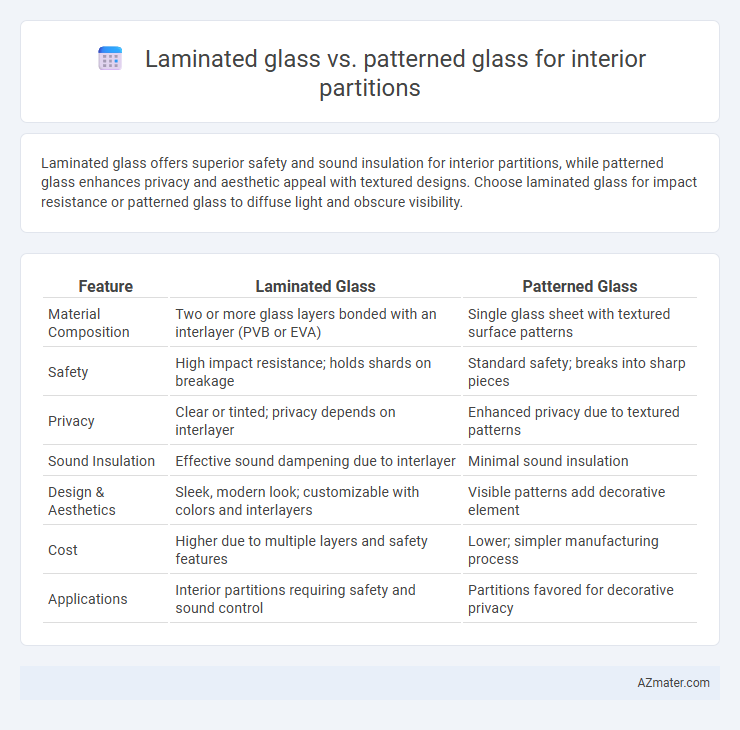Laminated glass offers superior safety and sound insulation for interior partitions, while patterned glass enhances privacy and aesthetic appeal with textured designs. Choose laminated glass for impact resistance or patterned glass to diffuse light and obscure visibility.
Table of Comparison
| Feature | Laminated Glass | Patterned Glass |
|---|---|---|
| Material Composition | Two or more glass layers bonded with an interlayer (PVB or EVA) | Single glass sheet with textured surface patterns |
| Safety | High impact resistance; holds shards on breakage | Standard safety; breaks into sharp pieces |
| Privacy | Clear or tinted; privacy depends on interlayer | Enhanced privacy due to textured patterns |
| Sound Insulation | Effective sound dampening due to interlayer | Minimal sound insulation |
| Design & Aesthetics | Sleek, modern look; customizable with colors and interlayers | Visible patterns add decorative element |
| Cost | Higher due to multiple layers and safety features | Lower; simpler manufacturing process |
| Applications | Interior partitions requiring safety and sound control | Partitions favored for decorative privacy |
Introduction to Laminated and Patterned Glass
Laminated glass consists of two or more glass layers bonded with an interlayer, offering enhanced safety, sound insulation, and durability for interior partitions. Patterned glass features textured surfaces that provide privacy and decorative appeal while allowing light transmission, making it ideal for stylish interior divisions. Both materials serve functional and aesthetic purposes in modern interior design, with laminated glass prioritizing strength and patterned glass emphasizing visual texture.
Key Differences Between Laminated and Patterned Glass
Laminated glass consists of two or more glass layers bonded with an interlayer, offering enhanced safety, sound insulation, and structural strength ideal for interior partitions requiring durability and security. Patterned glass features textured or embossed designs on one surface, providing privacy and decorative aesthetics while allowing light transmission but lacking the impact resistance of laminated glass. The primary differences lie in laminated glass's superior safety performance and soundproofing compared to patterned glass's focus on visual privacy and style for interior spaces.
Safety and Security Considerations
Laminated glass offers superior safety for interior partitions due to its interlayer that holds shards in place upon impact, reducing injury risk and enhancing security by preventing easy penetration. Patterned glass, while providing privacy through textured surfaces, lacks the same structural integrity and impact resistance, making it less effective for safety-critical applications. Choosing laminated glass ensures compliance with building codes focused on occupant protection and vandalism resistance in interior spaces.
Acoustic Performance Comparison
Laminated glass offers superior acoustic insulation for interior partitions due to its sandwich structure with a sound-dampening interlayer that significantly reduces noise transmission. Patterned glass, while providing aesthetic texture and privacy, generally lacks the soundproofing properties of laminated glass as it is usually a single pane without specialized acoustic layers. For environments demanding enhanced noise control, laminated glass is the preferred choice, achieving higher Sound Transmission Class (STC) ratings and improved ambient noise reduction.
Privacy Levels: Laminated vs Patterned Glass
Laminated glass offers enhanced privacy levels by incorporating an interlayer that can be customized with frosted, tinted, or printed designs to obscure visibility while maintaining sound insulation. Patterned glass provides moderate privacy through surface textures like rain, reed, or linen patterns that distort view without completely blocking light transmission. For interior partitions, laminated glass suits environments demanding higher confidentiality, whereas patterned glass balances privacy with aesthetic light diffusion.
Aesthetic Options and Design Flexibility
Laminated glass offers superior design flexibility with its ability to incorporate various interlayers such as tinted, frosted, or colored films, allowing for custom patterns and enhanced safety features in interior partitions. Patterned glass provides a wide range of textures and patterns, delivering unique aesthetic options that diffuse light and add privacy without compromising natural illumination. Combining laminated glass with patterned surfaces maximizes creative possibilities, enabling tailored transparency, opacity, and decorative effects essential for modern interior design.
Maintenance and Durability Factors
Laminated glass offers superior durability and safety for interior partitions due to its interlayer that holds shards together upon impact, minimizing maintenance by reducing the risk of breakage and scratches. Patterned glass, while aesthetically versatile, tends to accumulate dust and grime within its textured surface, requiring more frequent cleaning and greater care to maintain clarity and appearance. Maintenance efforts for laminated glass primarily involve routine cleaning with non-abrasive agents, whereas patterned glass may demand specialized cleaning tools to ensure long-term visual appeal and avoid damage to the surface pattern.
Energy Efficiency and Light Transmission
Laminated glass for interior partitions offers superior energy efficiency due to its enhanced insulation properties, reducing heat transfer and maintaining consistent indoor temperatures. Patterned glass allows for higher light transmission while providing privacy, effectively diffusing natural light to reduce reliance on artificial lighting. Choosing laminated glass optimizes thermal performance, whereas patterned glass excels in maximizing daylight penetration with moderate energy savings.
Cost Implications for Interior Partitions
Laminated glass typically incurs higher initial costs than patterned glass due to its multi-layer construction and enhanced safety features, making it a more premium option for interior partitions. Patterned glass is generally more cost-effective, offering decorative aesthetics with lower fabrication expenses, but it may lack the impact resistance and sound insulation qualities of laminated glass. Budget-conscious interior projects often prioritize patterned glass for its affordability, while laminated glass suits high-end applications where durability and safety justify the increased investment.
Choosing the Right Glass for Your Space
Laminated glass offers enhanced safety and sound insulation, making it ideal for interior partitions in busy or noise-sensitive spaces. Patterned glass provides decorative appeal and privacy through its textured surfaces, perfect for areas requiring subtle light diffusion without sacrificing style. Selecting the right glass depends on balancing functional needs like durability and acoustics with aesthetic preferences and privacy requirements.

Infographic: Laminated glass vs Patterned glass for Interior partition
 azmater.com
azmater.com